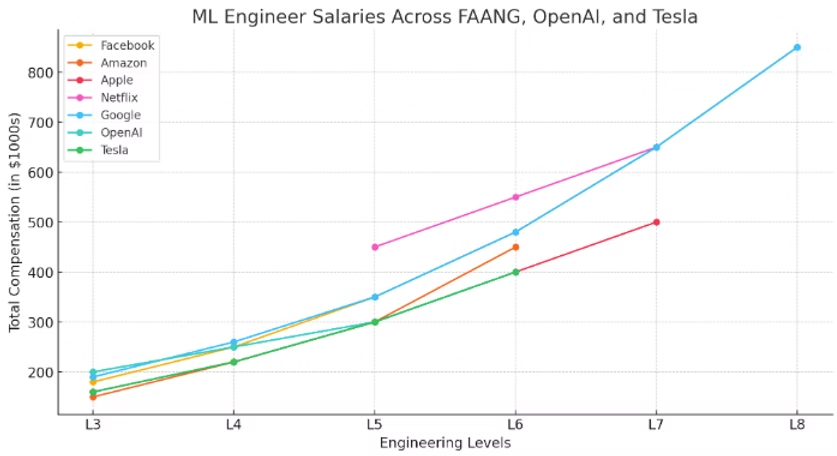In today's rapidly evolving tech landscape, Machine Learning (ML) engineers are at the forefront, driving innovations that shape our daily lives. Securing a position as an ML engineer at top-tier companies like FAANG (Facebook, Amazon, Apple, Netflix, Google), OpenAI, and Tesla is a coveted goal for many professionals. Understanding the compensation structures and leveling systems at these organizations is crucial for aspirants aiming to navigate their career paths effectively—and to compare ML engineer salaries at FAANG, Tesla, and OpenAI.
In this comprehensive guide, we'll delve into the salary ranges for ML engineers from entry-level (L1) to senior positions (L8) across these leading tech companies. We'll also explore the criteria these organizations use to assign levels and provide insights into what it takes to secure these roles.
1. Introduction
The demand for skilled ML engineers has surged in recent years, with companies investing heavily in artificial intelligence and machine learning to stay competitive. This demand has led to attractive compensation packages and a structured leveling system to categorize roles based on experience, expertise, and responsibilities.
2. Understanding Engineering Levels
Tech companies employ leveling systems to define roles, responsibilities, and compensation structures. While the exact nomenclature may vary, a general framework from L1 to L8 is often used:
L1-L3: Entry-level positions for new graduates or those with limited experience.
L4-L5: Mid-level roles requiring several years of experience and demonstrated proficiency.
L6-L7: Senior positions involving leadership, strategic decision-making, and significant impact.
L8: Executive roles with overarching responsibilities and influence over company direction.
Criteria for leveling include years of experience, technical skills, leadership abilities, and contributions to projects. Understanding these levels helps candidates align their career progression with industry standards.
3. FAANG Companies
3.1. Facebook
Facebook, now under the parent company Meta, categorizes its engineering roles from E3 to E9:
E3: Entry-level Engineer
E4: Engineer
E5: Senior Engineer
E6: Staff Engineer
E7: Senior Staff Engineer
E8: Principal Engineer
E9: Distinguished Engineer
According to data from levels.fyi, the compensation for ML engineers at Facebook is as follows:
E3: Total Compensation: Approximately $180,000
E4: Total Compensation: Approximately $250,000
E5: Total Compensation: Approximately $350,000
E6: Total Compensation: Approximately $480,000
E7: Total Compensation: Approximately $650,000
Note: Compensation includes base salary, bonuses, and stock options.
Criteria and Expectations:
E3-E4: Strong foundational knowledge in machine learning, proficiency in programming languages like Python or C++, and the ability to work collaboratively on projects.
E5-E6: Demonstrated experience in leading projects, developing scalable ML models, and contributing to research publications.
E7 and above: Leadership in driving ML strategy, mentoring junior engineers, and influencing product direction.
Tips for Aspiring Candidates:
Build a robust portfolio showcasing ML projects.
Contribute to open-source ML communities.
Stay updated with the latest research and advancements in machine learning.
3.2. Amazon
Amazon's leveling system includes:
L4: Software Development Engineer I
L5: Software Development Engineer II
L6: Senior Software Engineer
L7: Principal Engineer
L8: Senior Principal Engineer
Based on data from levels.fyi, the compensation for ML engineers at Amazon is:
L4: Total Compensation: Approximately $150,000
L5: Total Compensation: Approximately $220,000
L6: Total Compensation: Approximately $300,000
L7: Total Compensation: Approximately $450,000
Criteria and Expectations:
L4-L5: Proficiency in ML algorithms, experience with AWS services, and the ability to design and implement scalable solutions.
L6-L7: Leadership in project execution, mentoring team members, and driving innovation in ML applications.
Tips for Aspiring Candidates:
Gain experience with cloud-based ML solutions, particularly AWS.
Demonstrate the ability to handle large-scale data and deploy ML models in production.
3.3. Apple
Apple structures its engineering roles using the ICT (Individual Contributor Technical) framework:
ICT2: Software Engineer
ICT3: Senior Software Engineer
ICT4: Staff Software Engineer
ICT5: Senior Staff Software Engineer
ICT6: Principal Engineer
According to data from levels.fyi, the compensation for ML engineers at Apple is as follows:
ICT2: Total Compensation: Approximately $160,000
ICT3: Total Compensation: Approximately $220,000
ICT4: Total Compensation: Approximately $300,000
ICT5: Total Compensation: Approximately $400,000
ICT6: Total Compensation: Approximately $500,000
Note: Compensation includes base salary, bonuses, and stock options.
Criteria and Expectations:
ICT2-ICT3: Strong programming skills, foundational knowledge in machine learning, and the ability to work on product-focused teams.
ICT4-ICT5: Demonstrated experience in leading complex projects, developing innovative ML solutions, and mentoring junior engineers.
ICT6: Leadership in setting technical direction, influencing product strategy, and contributing to high-impact projects.
Tips for Aspiring Candidates:
Showcase experience in developing ML models that have been deployed in consumer products.
Highlight contributions to innovative solutions and patents in the ML domain.
Demonstrate a strong understanding of Apple's ecosystem and design principles.
3.4. Netflix
Netflix is known for its unique culture and operates with a flatter organizational structure. While specific levels are less emphasized, roles can be broadly categorized as:
Senior Software Engineer
Staff Software Engineer
Senior Staff Software Engineer
Based on available data, the compensation for ML engineers at Netflix is:
Senior Software Engineer: Total Compensation: Approximately $450,000
Staff Software Engineer: Total Compensation: Approximately $550,000
Senior Staff Software Engineer: Total Compensation: Approximately $650,000
Criteria and Expectations:
Senior Software Engineer: Expertise in ML algorithms, experience with large-scale data processing, and the ability to work autonomously.
Staff Software Engineer: Leadership in project execution, mentoring peers, and driving innovation in ML applications.
Senior Staff Software Engineer: Strategic influence on ML initiatives, setting technical direction, and contributing to company-wide projects.
Tips for Aspiring Candidates:
Emphasize a strong track record of delivering impactful ML solutions.
Demonstrate the ability to thrive in a high-performance, freedom-and-responsibility culture.
Showcase experience with scalable ML systems and personalized content recommendations.
3.5. Google
Google's engineering levels range from L3 to L8:
L3: Software Engineer II
L4: Software Engineer III
L5: Senior Software Engineer
L6: Staff Software Engineer
L7: Senior Staff Software Engineer
L8: Principal Engineer
According to levels.fyi, the compensation for ML engineers at Google is:
L3: Total Compensation: Approximately $190,000
L4: Total Compensation: Approximately $260,000
L5: Total Compensation: Approximately $350,000
L6: Total Compensation: Approximately $480,000
L7: Total Compensation: Approximately $650,000
L8: Total Compensation: Approximately $850,000
Criteria and Expectations:
L3-L4: Proficiency in programming, foundational ML knowledge, and the ability to contribute to team projects.
L5-L6: Experience in leading projects, developing scalable ML models, and mentoring junior engineers.
L7-L8: Leadership in setting technical direction, influencing product strategy, and driving company-wide initiatives.
Tips for Aspiring Candidates:
Build a strong portfolio of ML projects, including publications in reputable conferences.
Demonstrate experience with large-scale data and distributed systems.
Showcase contributions to open-source ML projects and communities.
4. OpenAI
OpenAI, as a leading AI research organization, offers competitive compensation packages. While specific leveling details are less publicly available, roles can be categorized as:
Research Engineer
Senior Research Engineer
Staff Research Engineer
Based on available information, the compensation for ML engineers at OpenAI is:
Research Engineer: Total Compensation: Approximately $200,000
Senior Research Engineer: Total Compensation: Approximately $300,000
Staff Research Engineer: Total Compensation: Approximately $400,000
Criteria and Expectations:
Research Engineer: Strong research background, proficiency in ML frameworks, and the ability to contribute to cutting-edge projects.
Senior Research Engineer: Leadership in research initiatives, mentoring junior researchers, and publishing in top-tier conferences.
Staff Research Engineer: Strategic influence on research direction, leading high-impact projects, and collaborating with external partners.
Tips for Aspiring Candidates:
Showcase a strong research portfolio with publications in top AI conferences.
Demonstrate experience in developing novel ML algorithms and models.
Highlight contributions to open-source AI projects and collaborations.
5. Tesla
Tesla's engineering roles are structured as follows:
P1: Software Engineer
P2: Senior Software Engineer
P3: Staff Software Engineer
P4: Senior Staff Software Engineer
According to levels.fyi, the compensation for ML engineers at Tesla is:
P1: Total Compensation: Approximately $160,000
P2: Total Compensation: Approximately $220,000
P3: Total Compensation: Approximately $300,000
P4: Total Compensation: Approximately $400,000
Criteria and Expectations:
P1-P2: Proficiency in programming, foundational ML knowledge, and the ability to work on real-time systems.
P3-P4: Experience in leading projects, developing scalable ML models, and contributing to autonomous systems.
Tips for Aspiring Candidates:
Demonstrate experience with real-time data processing and autonomous systems.
Showcase projects related to computer vision and sensor fusion.
Highlight contributions to innovative ML solutions in the automotive industry.
6. Comparative Analysis
When comparing compensation across these companies, several factors come into play, including company size, market position, and the nature of the work. Here's a general overview:
Entry-Level Positions (L3/L4): Compensation ranges from $150,000 to $190,000, with Google and Facebook offering higher packages.
Mid-Level Positions (L5/L6): Compensation ranges from $300,000 to $480,000, with Google and Facebook leading.
Senior Positions (L7 and above): Compensation exceeds $650,000, with Google offering up to $850,000 for L8 roles.
Note: These figures are approximate and based on available data.
7. Preparing for ML Engineering Roles
To secure a high-paying ML engineering role at these top companies, candidates should focus on the following:
Technical Skills
Proficiency in Python, C++, and Java, as they are widely used in ML development.
Expertise in machine learning frameworks like TensorFlow, PyTorch, and Scikit-learn.
Strong understanding of data structures, algorithms, and distributed computing.
Hands-on experience with cloud computing platforms (AWS, Google Cloud, Azure).
Interview Preparation
Coding Interviews: Focus on LeetCode-style problems (especially medium to hard problems).
System Design Interviews: Understand how to design and scale ML systems.
ML-Specific Interviews: Prepare for model optimization, feature engineering, bias mitigation, and real-world ML problem-solving.
Resources for ML Interview Preparation
Books: "Hands-On Machine Learning with Scikit-Learn & TensorFlow" by Aurélien Géron, "Grokking Deep Learning" by Andrew W. Trask.
Courses: Fast.ai, Stanford’s CS229, Google’s Machine Learning Crash Course.
Mock Interviews: Platforms like InterviewNode, Pramp, and TechMock.
Portfolio & Networking
Build a portfolio of ML projects showcasing real-world applications.
Contribute to open-source AI repositories (e.g., Hugging Face, TensorFlow, PyTorch).
Attend ML/AI conferences like NeurIPS, ICML, and CVPR.
Leverage LinkedIn and Twitter to follow industry leaders and share insights.
8. Conclusion
Machine Learning engineers are among the highest-paid professionals in tech, and FAANG, OpenAI, and Tesla offer lucrative compensation packages. Understanding the leveling system and knowing what each company expects can significantly improve your chances of landing these roles.
Key Takeaways:
FAANG pays well, with Google and Facebook offering some of the highest salaries at senior levels.
OpenAI focuses on research, and strong publications can be an advantage.
Tesla ML roles require expertise in real-time ML and autonomous systems.
Preparation is key—focus on coding, ML concepts, and system design.
Platforms like InterviewNode can help you master the ML interview process.

9. References
Levels.fyi (Compensation data)
OpenAI, FAANG, Tesla official job postings
ML interview prep books and courses






